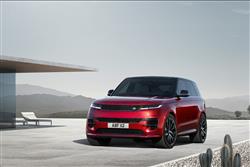Land Rover Range Rover Sport - ABC Leasing
How will you view?
This is a sample, showing 30 seconds of each section.
SPORT FOR ALL?(some text hidden)
By Jonathan Crouch
Ten Second Review word count: 64
The Range Rover Sport. The best of all worlds? You might think that Land Rover's flagship Range Rover model would be just about perfect if it was slightly more dynamically styled and slightly sharper to drive. That's just what the third generation Range Rover Sport aims to offer. It now feels like a six-figure SUV inside and out and there's nothing quite like it.
Background word count: 196
Here's a car that claims to be able to do.... well, almost everything. It'll cruise on the autobahn at 130mph, ford rivers in the Serengeti, take a family on holiday and slip you down to the shops. It can be affordable to run, rewarding to drive and looks dynamic and stylish. There has to be a catch - doesn't there? Time to check out the third generation Range Rover Sport. Ah yes, the Range Rover Sport. A car that in its first generation guise was neither a 'Range Rover' or 'sporty'. In fact, it was based almost entirely on the brand's sensible Discovery model and, thanks to that car's practical ladder frame chassis, as about as dynamic to drive. Still, the smarter set of clothes did the trick and for most of its life between 2005 and 2012, the MK1 'Sport' was one of Solihull's best sellers. The second generation model, launched in 2013 and updated in 2017, satisfied them far more credibly, based this time on the underpinnings of the fourth generation Range Rover. This MK4 design, which arrived in 2022, also shares a Range Rover chassis and powertrain, which means it's very advanced indeed.
Driving Experience word count: 533
Even with the standard passive engineering spec we tried, there's lots to admire about the way this car tackles the turns. Land Rover reckons the body structure is 35% stiffer than before, offering what the brand claims is 'sportscar levels of stiffness'. Air suspension, a dual chamber system, is now standard and has been designed both to limit cornering body roll and pitch under acceleration. The result is certainly a very different experience from driving an ordinary Range Rover, as you oversee things from the more focused 'Command Driving position'. The news on engines (still all mated to 8-speed ZF auto transmission) isn't that much different to what it was before. A diesel still suits the car best and a vastly powerful petrol V8 is still a bit over-the-top. What has changed a bit is the Plug-in Hybrid offering, which was well worth avoiding with the previous generation car but which now offers a more sensible alternative to DERV - and perhaps also to the full-EV version, which hadn't yet been launched at the time of this test. That's mainly because the PHEV engine now has six rather than four cylinders and there's a vastly larger 38.2kWh battery. To give you some perspective, that's bigger than the battery fitted in some small full-EVs (!) and of course it enormously improves this car's EV range (quoted at 72.1 miles - think 50 in the real world). As usual with Land Rovers, the model names designate horsepower. The main 3.0-litre PHEV unit (which we tried and liked last month in a Range Rover) is badged 'P460e' and makes 62mph in 5.5s en route to 140mph. With plush spec, there's also a fractionally faster P550e version of the same unit. We mentioned diesel; well that's what we tried in the fastest of the various mild hybrid flavours in which the usual 3.0-litre six cylinder unit is now being offered. You can theoretically have a base D250 version, but most choose the mid-range D300, which significantly improves the 62mph sprint to 6.1s en route to 135mph. The top D350 variant enhances those figures further to 5.5s and 145mph, but you're probably more likely to want to choose it because of its artificially enhanced but rather pleasingly snarly engine note. Is there really any need to go faster than that in a Range Rover Sport? The few who think so are offered the stupidly expensive 'SV Edition Two' flagship performance model. Unlike the old SV 'Sport' (which had the classic old 5.0-litre supercharged JLR unit), this one uses a 4.4-litre petrol V8 borrowed from BMW and putting out 635hp. Rest to 62mph requires 3.7s en route to 180mph; why would you? Answers on a postcard please. Whatever your powertrain of choice, highway cruising is effortless, spoiled only by a bit of undue wind noise from the boxy body. Ride quality's probably about 90% as good as a Range Rover, which means it's very good indeed. As before, the Range Rover Sport is unrivalled off road, with intelligently variable all-wheel drive and 'Terrain Response' with six settings. The air springs can offer a 135mm ride height increase, water up to 900mm deep can be forded and 45-degree gradients attempted.
Pictures (High res disabled)

.jpg)
.jpg)
.jpg)
.jpg)
.jpg)
.jpg)
.jpg)
.jpg)
.jpg)
.jpg)
.jpg)

Scoring
Category: Compact Car
| Performance | |
| Handling | |
| Comfort | |
| Space | |
| Styling | |
| Build | |
| Value | |
| Equipment | |
| Economy | 70% |
| Depreciation | 70% |
| Insurance | 50% |
| Total | 70% |